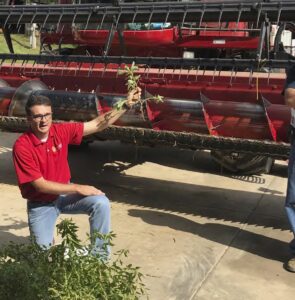 Crop harvest is here and that means it’s time to be thinking about weed seedbank management. Over the last few weeks we have observed fields throughout Wisconsin with a fair amount of weed escapes. Our UW Madison Division of Extension Weed Science Group offers the following information for consideration.
Crop harvest is here and that means it’s time to be thinking about weed seedbank management. Over the last few weeks we have observed fields throughout Wisconsin with a fair amount of weed escapes. Our UW Madison Division of Extension Weed Science Group offers the following information for consideration.
Weed seed in harvested crops can negatively impact a farm’s potential profits. Sometimes the impact can be immediate like crop yield reduction, the rejection of a grain load due to export market regulations; and at other times, it can set the stage for future problems like herbicide resistance and increased control costs.
Although weed seed can spread in ways that can’t be controlled (animals, wind), there are management strategies that can prevent seeds from further spreading farm to farm (cleaning equipment, hand weeding before harvest, reducing erosion).
The timing of weed seed control is also important; weed seed management at crop harvest is critical because at harvest, weeds that have survived other control attempts during the growing season and produced viable seed (also called weed escapes) can be spread from farm to farm if equipment is not properly and thoroughly cleaned. Many species have the potential to be troublesome but waterhemp has proven to be exceptionally challenging in recent years.
The most troublesome weeds in Wisconsin, waterhemp and giant ragweed, will retain their seeds well into October in the Upper Midwest. If you have weeds that have set seed in your field, now is the time to get out there, remove and burn them before combines start rolling. Check the “UW-NPM Weed Seed Management at Crop Harvest (PDF file)” handout located at: https://go.wisc.edu/00y6o8
If you are unable to remove weeds that have gone to seed, it is important to develop a sound harvest strategy to minimize the spread of weeds from field to field. This would include cleaning combines between fields and harvesting fields with severe weed infestations last.
Last fall, to validate our concerns of weed seed movement via combines, some UW-Madison Ag Extension Educators and stakeholders took take the time to clean and collect samples from combines before putting them away for the winter. Samples were from four specific locations: head, feeder house, rock trap, and rotor. In total 31 samples from nine different combines were collected. The seed samples were mixed the samples with field soil and potting mix in our greenhouse and observed what weeds emerged after two weeks.
The full report on the combine weed seed sampling project can be found at this link: https://go.wisc.edu/bhj8w3.
Here are some of the highlights:
- 97% of samples contained viable weed seed
- Combine head samples contained ~49% of the total weeds emerged, followed by the feeder house ~30%, rock trap ~19%, and rotor ~2%
- Most frequently observed weeds were grasses, pigweeds and common lambsquarters
- When time is limited, we believe that prioritizing the front of the combine (head and feeder house) would provide the most benefit in reducing weed seed spread by combines
Some additional tips for cleaning combines and reducing the spread of weeds:
- Use an air compressor or leaf blower to force air through and clear debris from critical portions of the combine
- Run a bag of wood shavings through the combine to clean rotor/auger area
Spending time to prevent the spread of troublesome weed seeds during harvest will help with weed management for many years to come on your farm.
Written by: Bill Halfman, Extension Monroe County, Agriculture Agent, email: william.halfman@wisc.edu
For more information, please contact:
Carolyn Ihde, Agriculture Agent, Extension Richland County by email: carolyn.ihde@wisc.edu




